Easy Homemade Curry Udon: A Quick, Comforting, and Flavorful Weeknight Meal
Welcome to our quick and simple guide to making a delicious Curry Udon recipe at home. This dish is the epitome of comfort food, making it absolutely perfect for a busy weeknight dinner or a cozy meal on a chilly evening. With just a handful of accessible ingredients and minimal prep time, you can create a profoundly satisfying meal that the entire family will adore. What makes this recipe truly special is its versatility; you can easily tailor the consistency of the curry sauce to your preference, whether you love thick, rich curry coating your chewy udon noodles or prefer them swimming in a delightful, aromatic curry broth.

table of contents
Toggle
About This Comforting Curry Udon Recipe
Japanese curry udon is a beloved comfort dish, particularly cherished for its warming qualities on a chilly evening. It brings together the irresistible robust flavors of Japanese curry with thick, delightfully chewy udon noodles and succulent, savory chicken thighs. This entire recipe is designed as a one-pot meal, ensuring it’s not only incredibly flavorful and delightful but also wonderfully filling and easy to clean up. The rich, aromatic curry sauce, which can be adjusted to your preferred consistency—from a thick, coating sauce to a more soupy broth—perfectly complements the tender chicken and the satisfying bite of the udon noodles.
There’s something uniquely appealing about the texture of udon noodles; their chewiness provides a fantastic counterpoint to the creamy, deeply flavorful curry. This homemade curry udon recipe empowers you to fully customize the dish to suit your individual taste preferences and dietary needs, whether that means adjusting the spice level, changing the protein, or adding extra vegetables. Our straightforward interpretation of this classic Japanese staple serves as an excellent entry point for anyone keen to explore Japanese cuisine, allowing even beginners to master this incredibly satisfying recipe with ease. It’s an ideal solution for those busy weeknights when you need a substantial and comforting meal without spending hours in the kitchen, proving that delicious, authentic flavors are well within reach for the home cook.
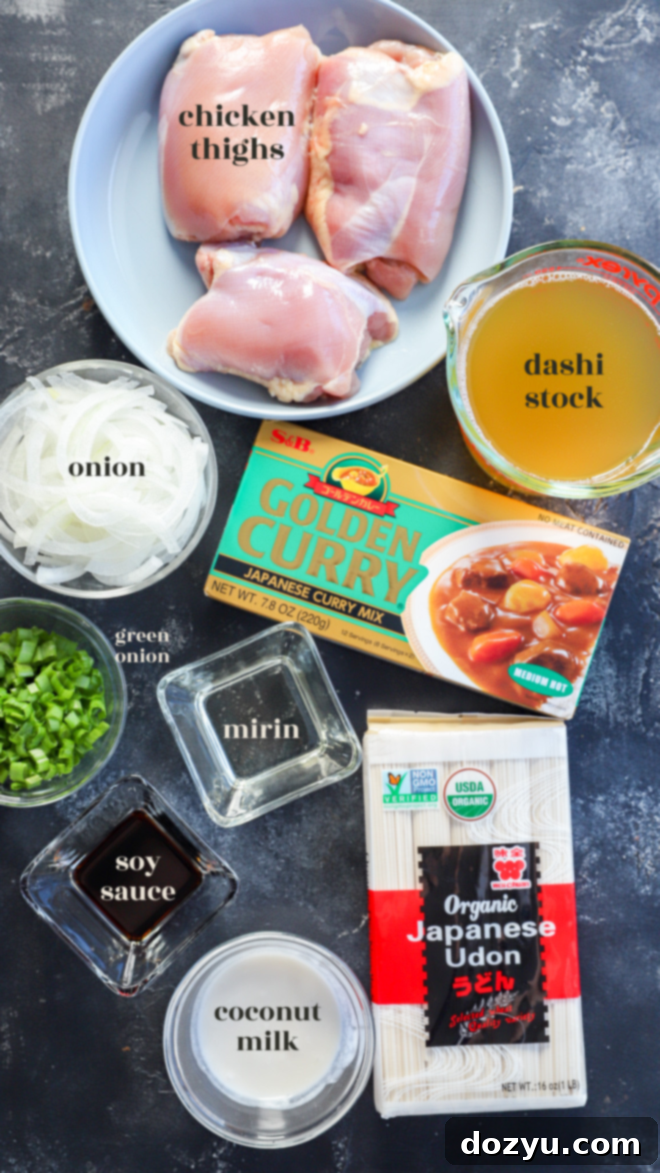
Essential Ingredients for Your Curry Udon
To create this magnificent bowl of Curry Udon, you’ll need a selection of key ingredients, each playing a vital role in developing the deep, layered flavors of the dish. Here’s a closer look at what you’ll need and why each component is essential:
Oil: A neutral cooking oil is best for this recipe, allowing the other flavors to shine through. Canola oil, vegetable oil, or light olive oil are all excellent choices. They provide the necessary fat for sautéing the chicken and onions without imparting a strong flavor of their own.
Chicken: For the most tender and flavorful results, we recommend using boneless, skinless chicken thighs. Chicken thighs retain moisture better than breasts, staying juicy and absorbing the curry flavors beautifully. Approximately 1 pound (2-3 thighs) is ideal for a dish serving four. Feel free to cut them into bite-sized pieces for easier eating.
Onion: Sliced white or yellow onion forms a crucial aromatic base for the curry. When sautéed until translucent, onions contribute a natural sweetness and depth that enhances the overall flavor profile of the sauce. They become soft and meld seamlessly into the curry.
Udon Noodles: The star of the show! Udon noodles are thick, chewy Japanese wheat noodles that provide a satisfying texture. You can find them fresh, frozen, or dried in most Asian markets or well-stocked grocery stores. Fresh or frozen udon often offer the best texture, but dried udon is a convenient pantry staple. Always follow package instructions for cooking, keeping in mind our tip to slightly undercook them initially.
Dashi Stock: This is the soul of Japanese cuisine, providing a rich umami base. Dashi can be made from kombu (kelp), katsuobushi (bonito flakes), or a combination. If traditional dashi stock isn’t readily available, you can substitute it with good quality chicken stock or vegetable stock for a savory foundation, though the flavor profile will be slightly different.
Mirin: A type of Japanese rice wine, mirin is similar to sake but with a lower alcohol content and higher sugar content. It adds a subtle sweetness and a beautiful glaze, along with an essential depth of flavor to the curry sauce. If mirin is unavailable, dry white wine or rice wine vinegar can be used as a substitute, adjusting for sweetness if necessary.
Soy Sauce: A fundamental seasoning in Asian cooking, soy sauce brings savory, umami notes and a touch of saltiness to the dish. Use your favorite brand, and opt for low-sodium soy sauce if you’re mindful of salt intake. It balances the sweetness of the mirin and the richness of the curry.
Salt: A pinch of kosher sea salt is all you need to perfectly season and enhance all the flavors in the curry. Seasoning in layers helps to build a more complex and satisfying taste.
Curry Roux: For convenience and authentic Japanese curry flavor, a block of Japanese curry roux is highly recommended. These come in cubes and dissolve easily, providing a rich, thick, and wonderfully spiced curry base. I personally love and use S&B Golden Curry Sauce Mix, which is widely available, including online platforms like Amazon. It comes in various spice levels, allowing you to choose your preferred heat.
Coconut Milk: Full-fat coconut milk adds a creamy richness and helps to mellow the curry’s intensity, creating a luxurious mouthfeel. It also adds a subtle tropical note that beautifully complements the other flavors. Don’t use light coconut milk here, as you’ll miss out on the desired creaminess.
Garnish: Fresh garnishes add brightness and a textural contrast. Sliced green onions (scallions) provide a mild oniony bite and vibrant color. Lime wedges offer a burst of refreshing acidity that cuts through the richness of the curry, elevating the flavors. For an extra layer of flavor and texture, consider adding pickled vegetables like daikon or carrots, or even a sprinkle of toasted sesame seeds.
Essential Equipment for Making Curry Udon
To prepare this delicious Curry Udon, having the right tools on hand will make the process smooth and enjoyable. You won’t need anything overly specialized, just a few kitchen staples:
First and foremost, you’ll need a **very large cast iron skillet** or a similar **high-sided skillet**. A cast iron skillet is fantastic for achieving a beautiful sear on the chicken, which builds a robust flavor foundation, and its generous size ensures there’s enough room to comfortably simmer the curry sauce and incorporate the noodles without overcrowding. A good quality nonstick 12-inch skillet, like the one I frequently use, also works wonderfully for this recipe, ensuring easy cleanup.
You will also need a **sturdy wooden spoon** for stirring and scraping up those delicious browned bits (fond) from the bottom of the pan, which are essential for developing deep flavors. Accurate **measuring cups** and **measuring spoons** are critical for ensuring the perfect balance of ingredients in your curry sauce.
Finally, keep a **medium to large saucepan** handy specifically for cooking the udon noodles. This allows you to cook the noodles separately and add them to the sauce at just the right moment, preventing them from becoming overcooked or mushy. Having these basic tools will set you up for success in creating a truly satisfying homemade Curry Udon.
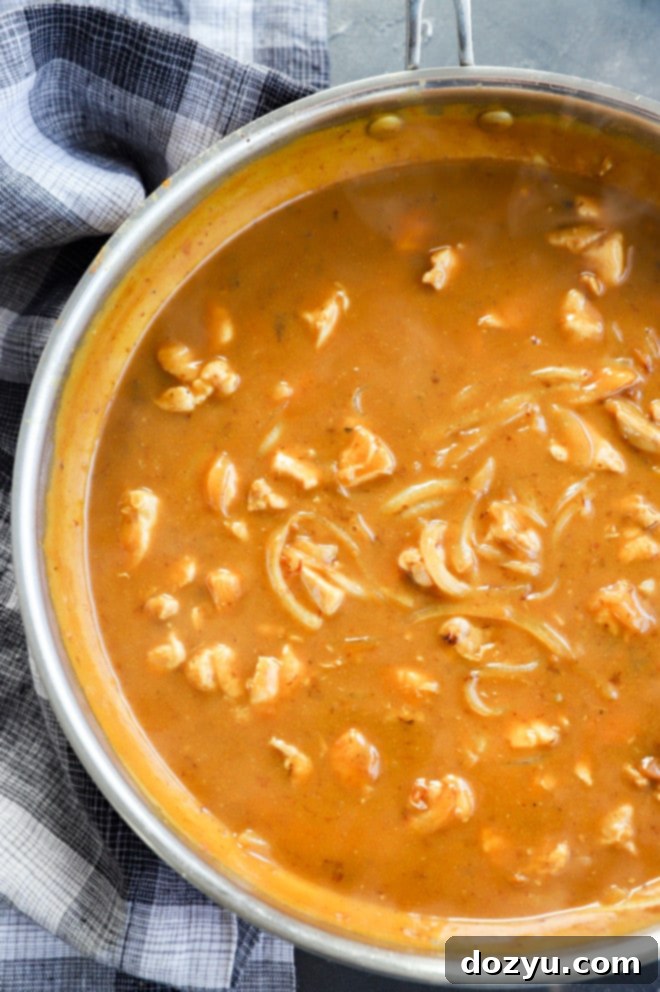
Here’s How to Make Flavorful Chicken Curry Udon
Crafting this hearty Chicken Curry Udon is a straightforward process, broken down into a few simple steps. Each stage is designed to build layers of flavor, resulting in a truly exceptional meal.
Step 1: Cook Chicken and Onions to Perfection
Begin by heating your chosen cooking oil in a large skillet over medium heat. The goal here is to get the pan hot enough to properly brown the chicken. Once the oil shimmers, carefully add your boneless, skinless chicken thighs. Cook them for about 5 to 6 minutes, ensuring they are beautifully browned on all sides. This browning, known as the Maillard reaction, is crucial as it develops deep, savory flavors that will form the backbone of your curry. Once browned, remove the chicken from the pan and set it aside in a bowl; it will finish cooking in the sauce later.
Next, add the thinly sliced onions to the same skillet. Cook them, stirring occasionally, for approximately 2 to 3 minutes, until they become soft and translucent. The onions will absorb some of the chicken’s flavorful drippings, adding another layer of sweetness and depth to the dish. Once translucent, remove the onions and add them to the bowl with the chicken, keeping all those delicious components together. While you’re working on this, remember to bring a separate saucepan of water to a rolling boil for your udon noodles.
Step 2: Craft the Rich Curry Sauce
Using the same skillet (don’t worry about rinsing it – those browned bits are flavor!), pour in the dashi stock. Immediately use a wooden spoon to scrape up any flavorful browned bits stuck to the bottom of the pan. This process, called deglazing, incorporates all that delicious fond into your sauce, enhancing its richness. Stir in the soy sauce, mirin, salt, and, most importantly, the Japanese curry roux cubes. Continue to stir gently until the curry cubes have completely dissolved into the liquid, creating a smooth, aromatic base. Bring this mixture to a gentle simmer and let it cook for a few minutes. This brief simmer allows the flavors to meld and deepen, preparing the sauce for the main ingredients.
Step 3: Prepare Your Udon Noodles
While your curry sauce is simmering and developing its flavors, turn your attention to the udon noodles. In the boiling, salted water you prepared earlier, cook the udon noodles according to package instructions, but aim to cook them for about 3 minutes less than the recommended time. This ensures the noodles are slightly al dente and won’t become mushy when they’re combined with the hot curry sauce. Al dente noodles will also better absorb the sauce’s flavors. Once cooked to this stage, drain the noodles thoroughly and set them aside. They’re almost ready for their curry bath!
Step 4: Combine and Serve Your Curry Udon
After the sauce has simmered for a few minutes, gently return the cooked chicken and translucent onions to the pan. Stir everything together to ensure the chicken and onions are well coated in the fragrant curry sauce. Allow the mixture to simmer for another 3 to 5 minutes. This is your chance to adjust the sauce’s consistency to your liking: if you prefer a thicker, more luscious sauce that generously coats the noodles, continue to cook it a little longer to allow it to reduce. If you desire a thinner, more broth-like consistency, simply add a bit more dashi stock until it reaches your desired texture.
Finally, stir in the coconut milk, mixing until it is fully incorporated and the sauce turns a beautiful creamy hue. Add the prepared udon noodles to the skillet and stir gently, ensuring every strand is coated in the rich curry. Continue to cook for just about a minute or so, until the entire dish is warmed through. Serve your homemade Curry Udon immediately in large bowls, garnished generously with freshly sliced green onions. For an extra burst of freshness and acidity, a squeeze of lime juice just before serving is highly recommended. Enjoy this comforting and satisfying meal!
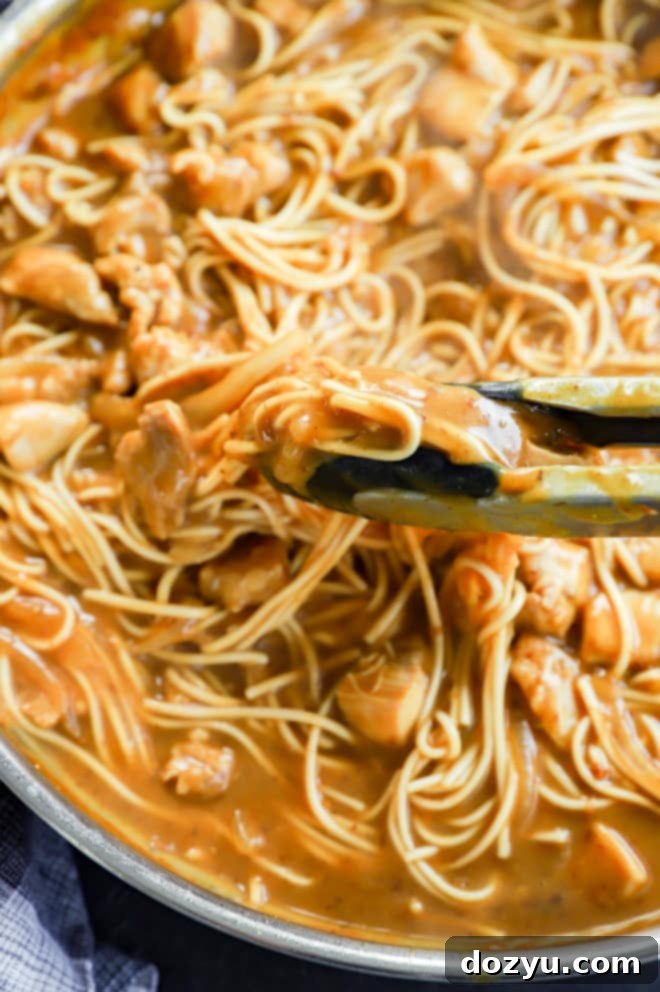
Expert Tips and Tricks for Your Best Curry Udon
Mastering Curry Udon at home is easy, and these tips will help you personalize and perfect your dish every time:
Adjust the Consistency: The beauty of homemade curry udon lies in its adaptability. You have full control over the sauce’s texture. To make the curry sauce thicker and richer, simply let it simmer for a longer period, allowing it to reduce naturally. The water will evaporate, concentrating the flavors and thickening the sauce. For a more soupy, broth-like consistency, add an extra splash of dashi stock (or chicken/vegetable stock) during the simmering stage. This allows the noodles to truly swim in a flavorful broth, offering a different but equally delightful experience.
Add More Spice: If the medium heat of the Japanese curry roux isn’t quite enough for your palate, don’t hesitate to amp up the spice. A drizzle of Sriracha sauce or a pinch of cayenne pepper stirred into the finished dish can add a delightful kick. You could also experiment with a dash of your favorite chili oil or a few drops of a hot sauce designed for Asian cuisine. Taste as you go to find your ideal heat level.
Incorporate Some Acid: A touch of acidity can brighten the entire dish and prevent the rich curry from feeling too heavy. I highly recommend serving this dish with fresh lime wedges. A squeeze of fresh lime juice just before eating adds a zingy, fresh counterpoint that beautifully cuts through the creamy richness of the curry, enhancing all the flavors. Rice vinegar or a tiny splash of apple cider vinegar can also work if you don’t have lime.
Experiment with Different Meats: While chicken thighs are fantastic in this recipe, feel free to get creative with other proteins. Thinly sliced pork belly or pork shoulder, beef (such as sirloin or short ribs), or even ground meat can be excellent alternatives. Adjust cooking times as needed to ensure the meat is fully cooked and tender. Marinating tougher cuts briefly can also enhance their flavor and tenderness.
Boost with Vegetables: Curry Udon is a fantastic vehicle for adding more vegetables to your diet. Incorporate hardy vegetables like sliced carrots, bell peppers, or broccoli florets during the initial sautéing stage with the onions, allowing them to soften. Leafy greens such as spinach or bok choy can be stirred in at the very end of cooking, just until they wilt, adding freshness and nutrients without overcooking. Mushrooms (shiitake or cremini) also make a wonderful addition, providing extra umami.
More yummy noodle recipes to try: Gochujang Noodles | Lemon Ricotta Pasta | Singapore Street Noodles | Farmers Market Pasta
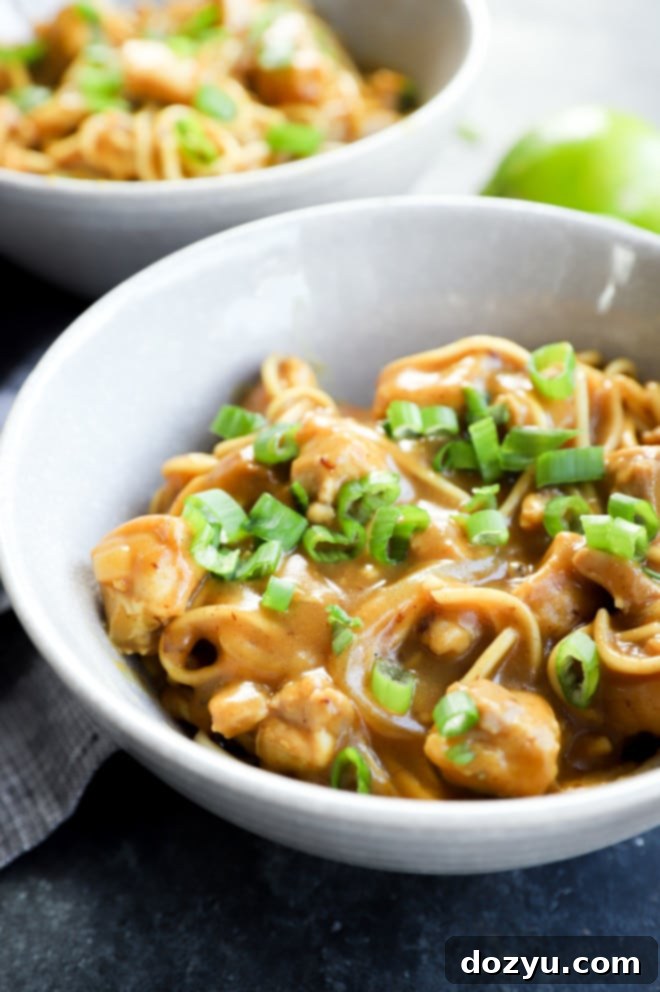
Shouldn’t the Sauce Be More of a Broth?
This is a fantastic question and truly highlights one of the most wonderful aspects of Japanese curry udon: its incredible versatility and adaptability to individual preferences. While some traditional variations of curry udon feature a thinner, more broth-like consistency, many modern interpretations and personal preferences lean towards a thicker, richer sauce that generously coats the udon noodles and protein. I, for one, absolutely adore the decadent, sauce-like consistency; I find it immensely comforting as it clings to every chewy strand of udon and succulent piece of chicken. This thick sauce creates a more substantial, almost stew-like experience, perfect for a deeply satisfying meal.
However, if your preference is for a lighter, more soupy broth, achieving that is incredibly simple! You can easily adjust the consistency by adding more dashi stock (or your chosen substitute like chicken or vegetable stock) to the curry as it simmers. Additionally, you can reduce the simmering time for the sauce. A shorter simmer will result in less liquid evaporation, keeping the sauce thinner and more broth-like. Feel free to experiment by adding small amounts of stock and tasting until you reach your ideal, delightfully slurpable consistency. Whether you favor a thick, luxurious curry or a lighter, more brothy version, this recipe is designed to be flexible and cater to your culinary desires.
What Type of Udon Noodles Should I Use?
Udon noodles, known for their distinct thick and chewy texture, are available in several forms, each with its own advantages. The choice often comes down to what’s available and your personal preference:
- Fresh Udon Noodles: These are often found in the refrigerated section of Asian grocery stores. They typically have the best texture—wonderfully soft, plump, and chewy—and cook very quickly, usually in just a few minutes. If you can find them, they’re often the top choice for an authentic experience.
- Frozen Udon Noodles: A fantastic option that rivals fresh udon in texture. Frozen udon maintains its chewiness beautifully and is incredibly convenient, cooking directly from frozen in boiling water in just a few minutes. Look for them in the freezer aisle of Asian supermarkets.
- Dried Udon Noodles: These are a great pantry staple, readily available in most grocery stores’ international aisles. While they may not always have the exact same bounce as fresh or frozen, they still offer a satisfying chew. They require a slightly longer cooking time, similar to other dried pasta. Having a pack of dried udon on hand means you can whip up this curry udon recipe anytime without needing fresh ingredients, making spontaneous cooking a breeze.
- Homemade Udon Noodles: For the truly ambitious, making udon noodles from scratch offers the freshest possible result and a deeply rewarding cooking experience. However, this is a more time-consuming process.
Regardless of the type you choose, the key is to ensure you don’t overcook them. Udon noodles are best when they retain a slight chewiness. Our recipe suggests cooking them for a few minutes less than package instructions before adding them to the sauce to prevent them from becoming mushy. Experiment with different types to discover your favorite!
Can I Make This Curry Udon Recipe Vegetarian?
Absolutely! This Curry Udon recipe is incredibly flexible and can be easily adapted to be fully vegetarian or even vegan. The rich curry sauce provides so much flavor that the absence of meat is barely noticeable. Here’s how you can make it vegetarian:
- Omit the Chicken: Simply leave out the chicken from the recipe.
- Use Vegetable Stock: Instead of dashi made with bonito flakes (which is fish-based), ensure you use a high-quality vegetable stock. Many instant dashi powders also contain fish, so double-check the ingredients or opt for kombu (kelp) based dashi if you want a truly vegan dashi.
- Add Plant-Based Protein: To keep the dish hearty and satisfying, consider adding plant-based proteins. Firm or extra-firm tofu, pressed and cubed, then lightly fried until golden, would be an excellent addition. Tempeh or even chickpeas could also work.
- Load Up on Vegetables: This is a perfect opportunity to add a wider variety of vegetables. Beyond onions, consider:
- Mushrooms: Sliced shiitake, cremini, or oyster mushrooms add a wonderful umami depth.
- Root Vegetables: Diced carrots, potatoes, or sweet potatoes can be added with the onions to cook until tender in the curry.
- Leafy Greens: Spinach, bok choy, or napa cabbage can be stirred in at the very end until just wilted.
- Other Vegetables: Bell peppers, snap peas, or broccoli florets also work well.
By making these simple substitutions, you can enjoy a delicious and satisfying bowl of vegetarian curry udon that’s rich in flavor and packed with wholesome ingredients.

What is Mirin and Why is it Important?
Mirin is a fundamental ingredient in Japanese cuisine, often described as a type of sweet rice wine, similar to sake but with a notably lower alcohol content (typically around 14% or less) and a significantly higher sugar content. It plays a crucial role in many Japanese dishes, imparting a delicate sweetness, a distinct umami flavor, and a beautiful, glossy sheen to food. In this Curry Udon recipe, mirin is absolutely vital because it contributes several key elements:
- Sweetness: It balances the savory and spicy notes of the curry roux and soy sauce.
- Umami: Like sake, mirin adds a layer of depth and savory richness that elevates the overall flavor profile of the sauce.
- Aroma: It provides a subtle, pleasant aroma that is characteristic of authentic Japanese cooking.
- Gloss: Mirin gives the sauce a lovely glaze, making the dish visually appealing.
I find that pairing mirin with soy sauce, as we do in this curry udon recipe, creates an incredible depth of flavor that is truly unique and comforting. You can typically find mirin in the Asian section of most well-stocked grocery stores or at specialty Asian markets. When purchasing, look for “hon mirin” (true mirin) for the best quality, although “aji-mirin” (mirin-like seasoning) is a common and acceptable substitute.
If you find yourself unable to locate mirin, either in stores or online, there are a couple of suitable substitutes, though they will alter the flavor slightly:
- Dry White Wine or Sake: Use 1 tablespoon of dry white wine or sake mixed with 1/2 teaspoon of sugar for every tablespoon of mirin.
- Rice Wine Vinegar: For a non-alcoholic option, use rice wine vinegar with a pinch of sugar. The flavor will be tangier, so use sparingly and adjust to taste.
What is Dashi and Why is it Essential?
Dashi is the foundational broth in Japanese cuisine, renowned for its delicate yet profoundly savory “umami” flavor. It’s not just any stock; dashi is the invisible backbone of countless Japanese dishes, from miso soup to noodle broths, and it’s absolutely essential for achieving an authentic flavor in your Curry Udon. The simplicity of dashi belies its incredible depth.
Traditional dashi is most commonly made from one or a combination of ingredients:
- Katsuobushi (Dried Bonito Flakes): These impart a smoky, savory, and slightly fishy umami.
- Kombu (Dried Kelp): Provides a clean, sweet, and oceanic umami flavor.
- Shiitake Mushrooms: Dried shiitake mushrooms offer a rich, earthy umami, often used in vegetarian dashi.
I often find pre-made liquid dashi at local Asian grocery stores, which offers immense convenience. Alternatively, you can easily make your own dashi stock using instant dashi powder (granules) by simply dissolving it in hot water. This powdered form is widely available and a great shortcut for home cooks.
The beauty of dashi lies in its ability to enhance and harmonize other flavors without overpowering them. In this Curry Udon, dashi provides a light yet complex base that allows the curry spices and other ingredients to truly shine, contributing a depth that water or other stocks simply cannot replicate. If you’re serious about exploring Japanese cooking, becoming familiar with dashi is a delightful journey.
What Japanese Curry Roux Should I Use?
For an authentic and incredibly convenient Japanese Curry Udon, using a pre-made Japanese curry roux is highly recommended. Unlike Indian or Thai curries, Japanese curry is typically made with a solid roux, which is a block or cube of flour, oil, and various curry powders and seasonings. This roux dissolves into hot liquid, creating a rich, thick, and wonderfully flavorful curry sauce with minimal effort.
These Japanese curry cubes are a game-changer for home cooks because they already contain a perfectly balanced blend of spices, thickening agents, and seasonings, ensuring excellent flavor and texture every time. You don’t need to worry about toasting spices or making a slurry; just drop them in, and they do the magic.
My go-to choice, and one I wholeheartedly recommend, is S&B Golden Curry Sauce Mix. It’s widely available, easy to find in most Asian supermarkets, international aisles of larger grocery stores, and can be conveniently ordered online from platforms like Amazon. S&B Golden Curry comes in various spice levels—mild, medium hot, and hot—allowing you to select the intensity that best suits your preference. I often opt for the medium hot for a balanced flavor with a gentle kick.
While you technically *could* create a curry from scratch using curry powder and a cornstarch slurry for thickening, it simply won’t yield the same unique, rich, and deeply umami flavor profile that Japanese curry roux provides. The pre-made roux has a distinct sweetness and complexity that is characteristic of Japanese curry, making it the best choice for this particular dish.
What if I Can’t Find Dashi Stock?
While dashi stock is crucial for achieving the most authentic Japanese flavor in your Curry Udon due to its unique umami profile, don’t worry if you can’t get your hands on it. This recipe is forgiving, and you can still create a delicious and comforting meal with readily available substitutes.
If dashi is unavailable, your best alternatives are:
- Chicken Stock: A good quality chicken stock provides a savory, rich base that will complement the curry flavors well. It offers a familiar depth and ensures your curry isn’t bland.
- Vegetable Stock: For a vegetarian or vegan version, or simply if you prefer, vegetable stock is an excellent choice. Opt for a low-sodium version if possible, so you can control the seasoning yourself.
It’s important to note that while these substitutes will still result in a very tasty dish, the flavor profile will be slightly different. Dashi provides a unique oceanic and umami depth that chicken or vegetable stock may not fully replicate. However, with the robust flavors of the Japanese curry roux, mirin, and soy sauce, your Curry Udon will still be incredibly satisfying and flavorful. Don’t let the absence of dashi deter you from trying this fantastic recipe!
Need more inspiration for dinner this week? Check out my main dishes recipe page!
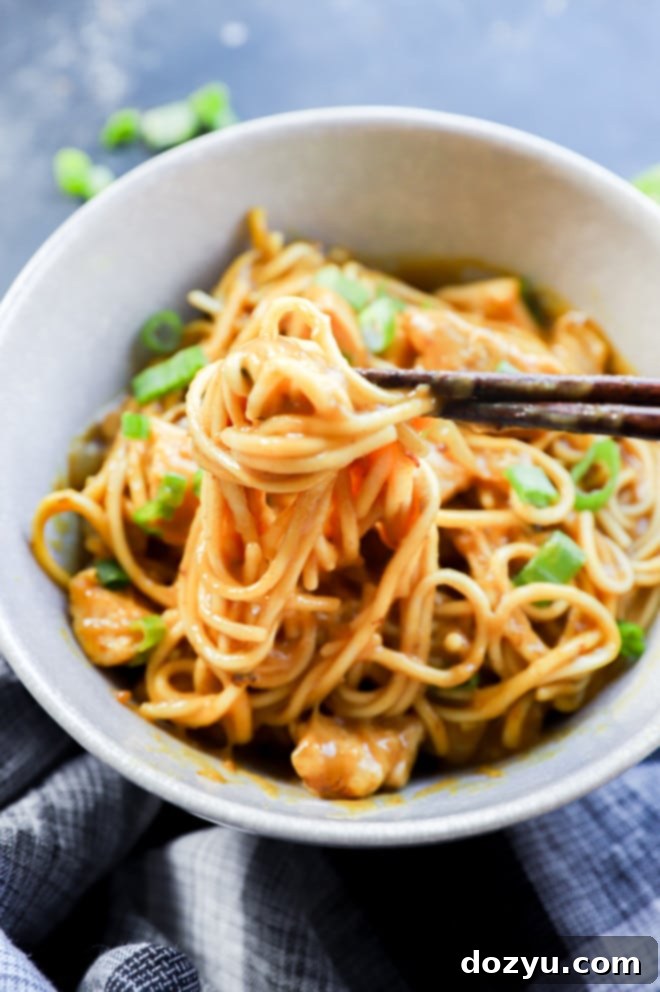
What to Eat with Curry Udon: Perfect Pairings and Toppings
Curry udon is a wonderfully complete meal in itself, offering a hearty combination of noodles, protein, and a rich sauce. However, a few simple additions or side dishes can elevate the experience even further, adding extra texture, flavor, or freshness.
Toppings and Garnishes: These are where you can really customize your bowl:
- Fried Egg: A sunny-side up or soft-boiled egg perched atop your curry udon adds a luscious, runny yolk that beautifully enriches the sauce.
- Pickled Vegetables: A sprinkle of quick-pickled daikon, carrots, or ginger provides a tangy crunch that contrasts wonderfully with the creamy curry.
- Fresh Greens: Stir in a handful of fresh spinach or thinly sliced bok choy at the very end of cooking, just until wilted, for a burst of vibrant green and added nutrients.
- Toasted Sesame Seeds: A light sprinkling adds a nutty flavor and a subtle crunch.
- Shichimi Togarashi: For those who love extra spice, a dash of this Japanese seven-spice blend adds complex heat and aroma.
Side Dishes: While not strictly necessary, a light side can complement the richness:
- Simple Side Salad: A crisp green salad with a light vinaigrette can provide a refreshing contrast to the hearty noodles.
- Steamed Rice: While udon is the primary carbohydrate, a small bowl of steamed rice can be served on the side, especially if you have extra sauce you want to savor.
Drink Pairings: To complete your meal, consider a refreshing beverage:
- Japanese Highball: A simple two-ingredient Japanese highball (whisky and soda) offers a crisp, bubbly contrast that cuts through the richness of the curry.
- Green Tea: A warm cup of Japanese green tea is a classic pairing, cleansing the palate between bites.
- Cold Beer: A light Japanese lager can also be a refreshing choice.
Ultimately, whether you enjoy this dish on its own or with a thoughtful accompaniment, Curry Udon is designed to be a deeply satisfying and delicious meal.
How to Store and Reheat Your Curry Udon
Curry Udon makes for fantastic leftovers, but proper storage and reheating techniques are key to maintaining its deliciousness. Here’s how to ensure your meal remains fresh and enjoyable:
Storage: Allow any leftover Curry Udon to cool completely to room temperature before storing. This is crucial to prevent bacterial growth and maintain food safety. Once cooled, transfer the curry udon to an airtight container. It can be safely stored in the refrigerator for up to 3 days. For best results, if possible, store the noodles and the curry sauce separately, as this helps prevent the noodles from absorbing too much liquid and becoming overly soft. However, if mixed, it will still be enjoyable.
Reheating: Reheating curry udon is simple, whether on the stovetop or in the microwave:
- Stovetop: This is generally the preferred method for reheating to best preserve texture. Transfer the leftover curry udon to a saucepan or skillet over medium-low heat. The sauce may have thickened considerably in the refrigerator, so add a splash of dashi stock, chicken stock, or even just water. Stir gently and continuously until the curry is warmed through and the sauce reaches your desired consistency. The added liquid helps to “give it new life” and prevent it from becoming too dry.
- Microwave: For a quicker option, place the curry udon in a microwave-safe bowl. Cover loosely (to prevent splatters and help retain moisture) and microwave on medium power in 1-2 minute intervals, stirring after each, until thoroughly heated. You may still want to add a small splash of liquid before microwaving to help rehydrate the sauce.
Freezing: I generally do not recommend freezing this recipe, primarily because of the udon noodles. Udon noodles, especially fresh or frozen ones, tend to become mushy and lose their desirable chewy texture after being frozen and then thawed and reheated. The sauce itself might freeze well, but the overall dish’s quality will significantly diminish. It’s best enjoyed fresh or as refrigerated leftovers within a few days.
More Delicious Weeknight Dinner Recipes to Try
If you loved the ease and flavor of this Curry Udon, you’re in for a treat! We have many other quick and satisfying recipes perfect for those busy weeknights when you crave a hearty, home-cooked meal without the fuss. Explore these other fantastic noodle and dinner options from our kitchen:
For a spicy kick, dive into these creamy Kimchi Udon! It’s a wonderfully tangy and spicy dish that you can easily bulk up with your favorite protein, making it incredibly versatile and flavorful. The fermented kimchi adds a unique depth that you’ll absolutely love.
If you’re in the mood for Italian comfort, our Bucatini Cacio e Pepe with Broccoli offers a creamy, peppery, and utterly delightful pasta experience. Made with super simple ingredients, it’s a sophisticated yet easy dish that brings a touch of Rome to your dinner table, with the added goodness of fresh broccoli.
For a robust and elegant poultry dish, try Roasted Chicken with White Wine and Fresh Herbs. This recipe proves that roasted chicken can be an easy and accessible weeknight meal, delivering tender, aromatic chicken that feels gourmet but requires minimal effort.
And for a classic Italian favorite ready in just 20 minutes, our Pasta Napolitana is the perfect dish. It’s a simple, vibrant, and incredibly flavorful Italian noodle dish that highlights fresh ingredients and quick preparation, ideal when time is of the essence.

We truly hope you enjoy making this Curry Udon recipe as much as we do. If you try it out, please be sure to give this recipe a rating and/or leave a comment! Your feedback means the world to us; we absolutely love hearing about your cooking adventures and we make it a point to respond to every single comment. Feel free to drop any questions you might have below—we’re here to help!
And for those who love to share their culinary creations, don’t forget to tag us on Instagram if you make the recipe! It’s genuinely our favorite thing to see these recipes come to life in your homes and get a glimpse of your delicious results. Seeing your photos really brightens our day and inspires us to keep creating more content for you.
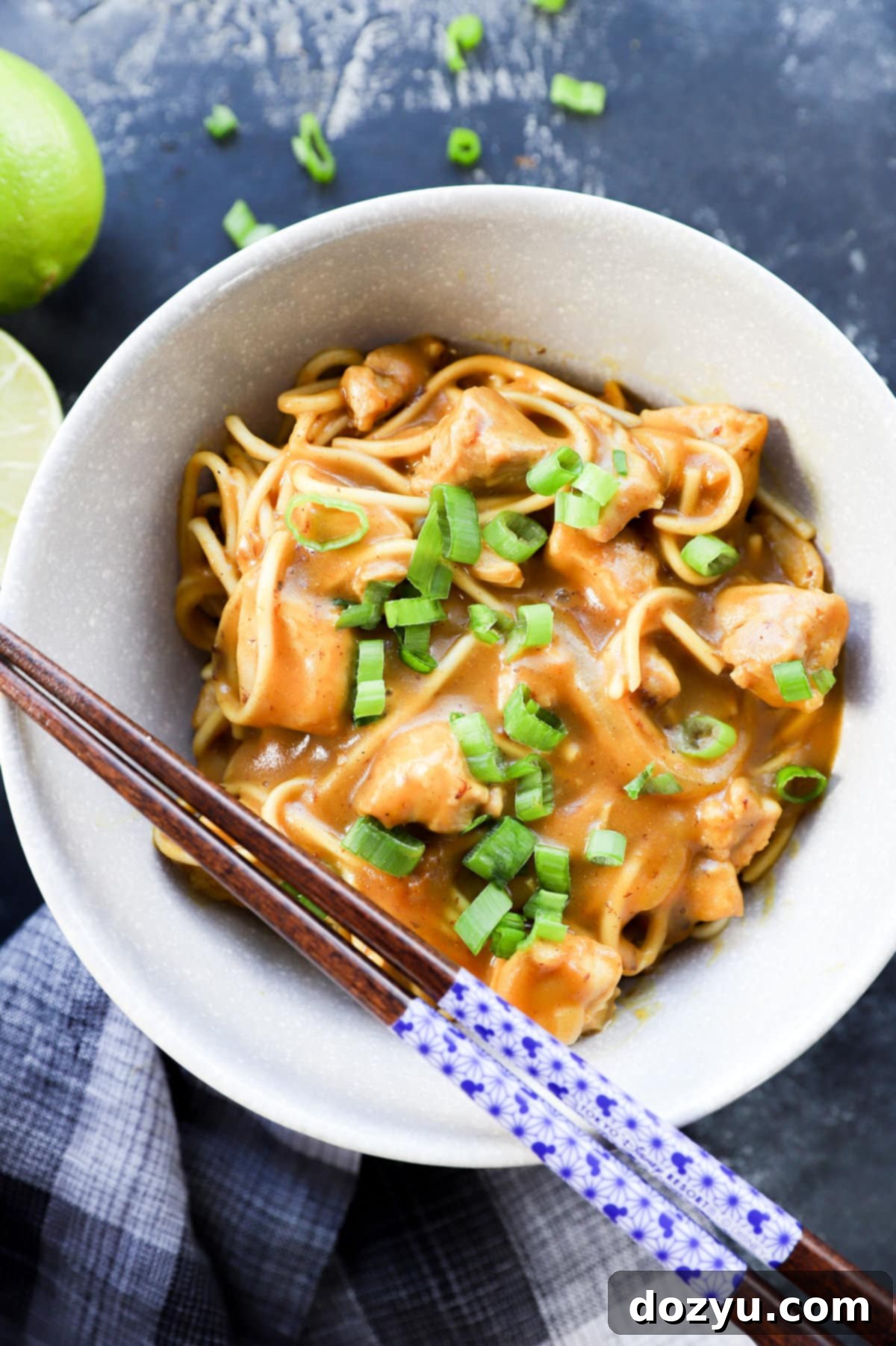
Curry Udon: A Quick & Comforting Japanese Noodle Dish
Equipment
-
Utility Cutting Board
-
8-Inch Chef’s Knife
-
Saucepan
-
Nonstick 12-Inch Skillet
-
Wooden Spoon
Ingredients
- 2 tsp canola oil
- 1 lb boneless skinless chicken thighs (about 2 to 3 chicken thighs)
- 1/2 yellow onion thinly sliced
- 3/4 lb to 1 lb udon noodles
- 2 1/2 cups dashi stock or vegetable or chicken stock
- 2 Tbsp mirin
- 1 Tbsp soy sauce
- 1/4 tsp salt
- 1 pack Japanese curry roux 4 small cubes
- 1/4 cup coconut milk
- Garnish: sliced green onion lime wedges
Instructions
-
Begin by bringing a large pot of water to a rolling boil. Season the water generously with salt; this will season your noodles from the inside out.
-
While the water heats, warm the oil in a large, high-sided skillet over medium heat. Once the oil is shimmering, add the chicken thighs and cook for about 5 to 6 minutes, ensuring they are beautifully browned on all sides. This step is crucial for developing deep flavor. Remove the browned chicken from the skillet and set it aside in a bowl.
-
Add the thinly sliced onions to the same skillet, stirring occasionally. Cook them for approximately 2 to 3 minutes until they become soft and translucent. Once cooked, transfer the onions to the bowl with the chicken.
-
Pour the dashi stock into the skillet, immediately using a wooden spoon to scrape up any flavorful browned bits from the bottom of the pan. Stir in the mirin, soy sauce, salt, and Japanese curry roux cubes. Continue stirring until the curry cubes are completely dissolved, forming a smooth, aromatic sauce. Bring this mixture to a gentle simmer and let it cook for 2 to 3 minutes to allow the flavors to meld.
-
While the sauce is simmering, cook the udon noodles in your boiling, salted water. Cook them for about 3 minutes less than the time specified on the package instructions. This ensures they are slightly al dente and won’t become mushy when added to the hot curry. Drain the noodles well and set them aside.
-
Return the browned chicken and translucent onions to the skillet with the curry sauce. Stir to combine everything thoroughly. Continue to simmer for 3 to 5 minutes, or until the sauce reaches your preferred consistency. For a thicker sauce, let it reduce slightly; for a thinner, more broth-like consistency, add a bit more dashi.
-
Add the cooked udon noodles to the skillet. Stir in the coconut milk, ensuring it is fully incorporated into the curry. Cook for another minute or so, stirring gently, until the entire dish is warmed through and the noodles are perfectly coated.
-
Serve your delicious Curry Udon immediately in bowls, garnished generously with freshly sliced green onions. A squeeze of fresh lime juice is also highly recommended for a burst of bright flavor.
